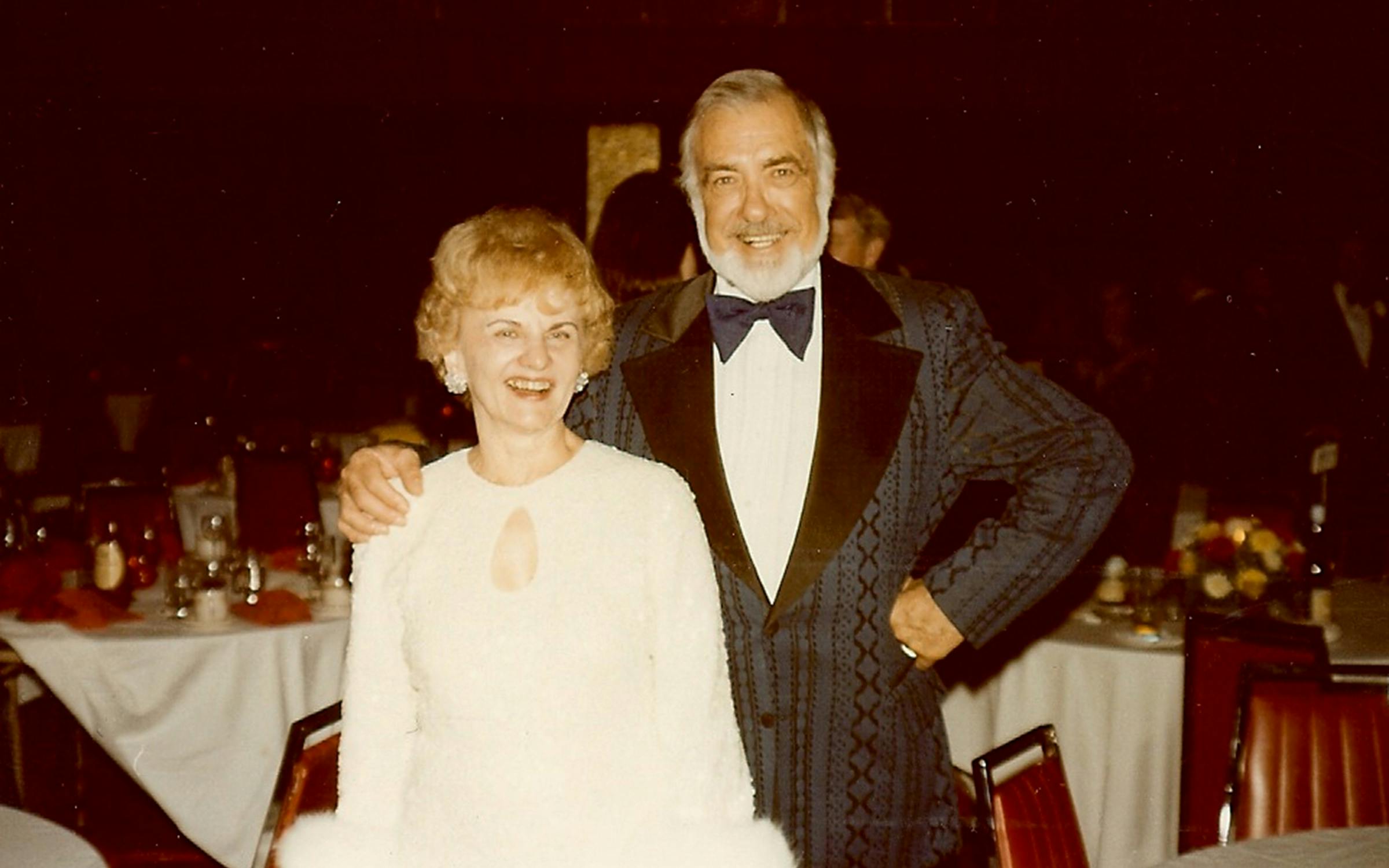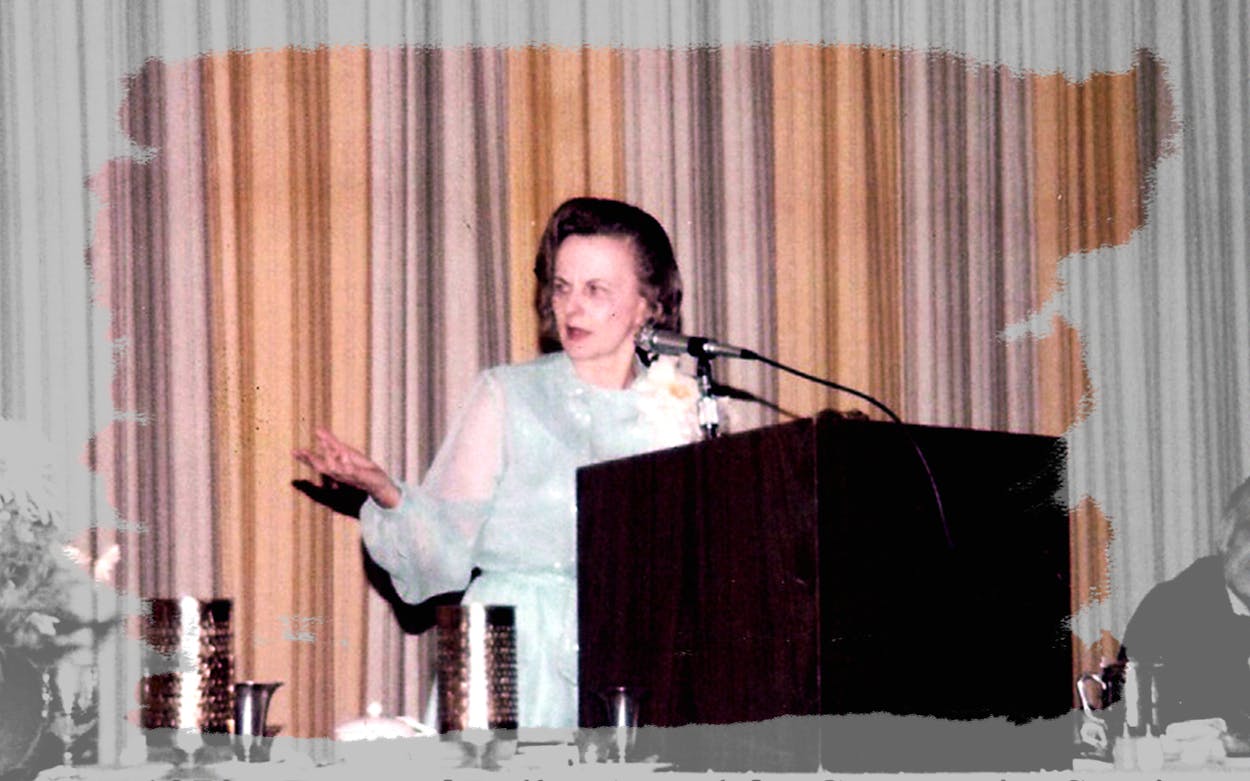Around this time of year, Louise Raggio’s three sons miss the smell of cookies wafting from the compact kitchen in their childhood home. On the minuscule counter space, she’d prepare dozens of fruitcakes, peanut butter confections, and lines of sugar cookies squeezed out of piping tubes to create dainty ridges in the dough. “She was not the cleanest person, but I never remember there being discord around the kitchen,” says her youngest, Kenneth, now 71. Raggio, a petite, blond, blue-eyed woman, would recruit her husband to help; she’d spend a full weekend baking, staying up late into the night to package the treats as gifts. She rarely indulged in sweets, but made them by the dozen for family, friends, and colleagues.
Raggio never looked like anything but an average, middle-class homemaker—and that’s exactly the way she wanted it. Frances Harris, a Dallas attorney and friend of Raggio’s, says she always had her hair done, wore sensible and stylish clothing, and never left the house without her signature shade of red lipstick. Those who knew her best say maintaining appearances was key to her many achievements. Raggio’s looks reflected her by-the-book personality, but they also helped her seem nonthreatening, paving the way for her to do subversive, feminist work. She was part of the first generation of female lawyers in Texas and the driving force behind the state’s Marital Property Act of 1967, a little-known but influential piece of legislation that gave married women the same rights as their husbands and paved the way for the country’s first unified family code. Prior to the law, which went into effect on January 1, 1968, women had the same rights as “infants, idiots and felons,” as Raggio wrote in her autobiography, Texas Tornado. Because Texas law required married women to receive permission from their husbands for every signature, lawsuit, and bank check, Raggio counted herself among the lawyers, businesswomen, and other female professionals who practiced illegally for much of their careers.
Raggio grew up in Manor, northeast of Austin, where her parents, the children of Swedish and German immigrants, taught her to launder and sew by hand. She also learned to cook meals with produce and meat mostly grown and raised on the family farm. Though the expectation in Depression-era Texas was for a girl to become a housewife, or perhaps a teacher, Raggio’s mother had bigger ambitions for her daughter, who graduated as valedictorian of Austin High School in 1936. With her farmer’s work ethic, Raggio held three jobs while earning her undergraduate degree at the University of Texas at Austin—or, as she remembered her pastor calling it, “a training ground for Hell.” She later enrolled in law school at Southern Methodist University, taking night classes while caring for her sons during the day. Raggio graduated in 1952 as the only woman in her class. In her first job after graduation, as an assistant district attorney in Dallas County, her diligence helped her stand out as she made her way through a backlog of domestic and juvenile crime cases. Through this work, she became aware of deep-rooted injustices within Texas’s family laws.
From the 1700s through the early 1800s, Spanish laws gave Texas frontierswoman a number of equal rights, including property ownership. But over time, explains Allison Faber, a doctoral student in history at Texas A&M University, there was an overwhelming push toward English common law. That included coverture, a legal doctrine under which women lost control of their property, income, and other assets to their husband upon marriage. “For this reason, you might notice that a lot of activists in the earlier part of the twentieth century were single women,” Faber says. “They didn’t have to deal with the same sort of legal discrimination married women did.”
Raggio drafted the Marital Property Act of 1967 while working at the Texas bar association, and she lobbied officeholders to push the legislation through. In part, lawmakers’ support of the bill was a reaction to their hatred of another push for equal rights by a women’s rights activist, attorney Hermine Tobolowsky. “The Legislature felt compelled to support either marital property law or [Tobolowsky’s] equal rights amendment,” explains Nancy Baker, a historian at Sam Houston State University who is writing a book about Texas’s female legal reformers. “[Tobolowsky] had made herself so unpopular with some of the state legislators that they basically called Lousie Raggio in and told her, ‘Tobolowsky hates this bill? Then we’re for it.’”Although Tobolowsky eventually got her way with the passage of the Texas Equal Legal Rights Amendment in 1972, Baker says that Raggio’s work laid the groundwork for that development and others.

The Marital Property Act of 1967 did not lead to immediate monumental change, but, according to Faber, the number of women-owned businesses in Texas increased after its passage. The bill later became part of Texas’s unified family code, which made it easier for lawyers to work within the set of family law statutes and identify inconsistencies. After she spearheaded that project in 1979, Raggio served as counsel to other states looking to reform their family codes, and she quipped that she brought Texas “from worst to first.” Today, Texas is ranked as one of the nation’s friendliest environments for female business owners and entrepreneurs.
Nevertheless, Raggio remains an obscure figure in Texas history. Unlike some second-wave feminists, she was not out on the streets burning bras. In part, this was because unlike many other activists of her time, she had children. “It was a pretty prevalent idea amongst women that once you had children you were out of the game,” Faber says. Even Sarah Hughes, Raggio’s mentor and Texas’s first female judge, wrote an article that argued against mothers of young children remaining in the workforce. Baker says Raggio’s understated feminism wasn’t just a reaction to prevalent stereotypes, it was a response to the McCarthyism that plagued her family for more than a decade in the forties and fifties. The FBI investigated her husband, Grier Raggio, after accusations that he was a communist sympathizer. Grier was already struggling with post-traumatic stress disorder after serving in World War II; Louise worried that he might become unable to work. That fear prompted her decision to go to law school. Ultimately, the experience also taught her to be careful about her public image. “She realized that she could get more done if she let the men around her believe that she was a dumb, helpless blonde,” Baker says. In her piece in the anthology Eavesdropping on Texas History, Baker writes that Raggio was able to get an early version of the Marital Property Act assigned to the Texas bar association’s Family Law Section by waiting until the bar president was drunk and buttering him up. The next day, she put the director’s agreement in writing with a letter thanking him for the assignment.
When Raggio wanted to get something done, “She would figure out a way to accomplish her goal, she would then identify the people who could help her, forge a relationship with them, and get it done,” says Harris. There are plenty of achievements modern Texans can thank Raggio for, but Harris cites one story that illustrates her powers of persuasion. In Raggio’s time, Harris says, the women’s restrooms at the Texas Capitol were little more than “toilets in a broom closet.” According to Harris, Raggio cornered a Texas Supreme Court justice after an event, dragged him into the dark and dingy women’s restroom, and asked, “Is this really what you’d expect for your wife and daughters?” It wasn’t long before the restrooms were renovated.
Raggio wanted not just to reform unjust laws but to show by example that women could be successful attorneys. She struggled to get her first job as a lawyer because of her gender, and didn’t want the next generation to face the same barriers. In her later years, Raggio was able to be forthright about her feminism and helped mentor a new generation of female lawyers. But all this work came with a price. Kenneth Raggio remembers that his mother’s long days didn’t stop when she left the office. She also spent evenings and weekends entertaining and cooking for colleagues and legislators. At the same time, she wanted to give her children a normal life and would do meal prep each weekend. “She was trying to be Superwoman,” Baker says. In Texas Tornado, Raggio recalls the depression she endured in the late sixties and early seventies. “I would begin to feel incompetent, helpless, hopeless,” she wrote. “In the depths of each episode, I lost interest in everything and felt I didn’t have enough sense to push an elevator button.” Fearing the stigma of mental illness, and confusing her depression for personal weakness, Raggio mostly kept her struggles to herself, and was able to overcome the worst symptoms after years of family help and medical treatment.
Raggio’s sons say that her biggest success wasn’t in the laws she helped pass but in the passion for the law that she passed down to them. All three of Raggio’s sons went to law school and then worked for their mother and father’s divorce and family law firm, where two of them, Kenneth and Tom Raggio, carry on the practice. To this day, says Kenneth, the brothers refer to their mother as Louise, or sometimes Mrs. Raggio, out of respect. Raggio’s daughter-in-law Janice Raggio remembers when her daughter, Kristin, brought a photo of her grandmother to her first-grade class for show-and-tell in the late eighties. The portrait had accompanied a feature in the latest edition of The Dallas Morning News’ High Profile section, which chronicled the lives of powerful, wealthy, and influential Dallasites. The teacher asked the shy six-year-old, “What is your grandma famous for?” Her reply: “Her homemade vegetable soup.”
Unlike Raggio, my mother can hardly boil a pot of water. But, like her, she is the daughter of cultural outsiders—in my mother’s case, two Tejanos from south of San Antonio who scrimped and saved to send their daughter and son to Yale. Years later, after my mother became a lawyer, I remember watching the door anxiously in the evenings, waiting for her to come home after a long day at the office. My mother had options in life. She once dreamed about becoming a children’s book author. She could have been a homemaker. But what she wanted most, and the thing she wanted for me, was independence. Thanks to Raggio, neither of us had to choose.
- More About:
- Texas History
- Texas Legislature
- Dallas






